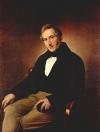Biography
Alessandro Francesco Tommaso Manzoni (7 March 1785 - 22 May 1873) was an Italian poet and novelist. He is famous for the novel The Betrothed, one of the major works of Italian literature.
Manzoni was born in Milan, Italy, on 7 March 1785. Pietro, his father, aged about fifty, belonged to an old family of Lecco, originally feudal lords of Barzio, in the Valsassina. The poet's maternal grandfather, Cesare Beccaria, was a well-known author, and his mother Giulia had literary talent as well.
Alessandro Manzoni was a slow developer, and at the various colleges he attended he was considered a dunce. At fifteen, however, he developed a passion for poetry, and wrote two sonnets of considerable merit. Upon the death of his father in 1805, he joined the freethinking household of his mother at Auteuil, and spent two years mixing with the literary set of the so-called "ideologues", philosophers of the 18th-century school, among whom he made many friends, notably Claude Charles Fauriel. There too he imbibed the anti-Catholic creed of Voltairianism.
In 1806-1807, while at Auteuil, he first appeared before the public as a poet, with two pieces, one entitled Urania, in the classical style, of which he became later the most conspicuous adversary, the other an elegy in blank verse, on the death of Count Carlo Imbonati, from whom, through his mother, he inherited considerable property, including the villa of Brusuglio, thenceforward his principal residence.
In 1808 Manzoni married Henriette Blondel, daughter of a Genevese banker. She came from a Calvinist family, but in 1810 she became a Roman Catholic. Her conversion profoundly influenced her husband. That same year he experienced a religious crisis which led him from agnosticism to an austere form of Catholicism.Manzoni's marriage proved a most happy one, and he led for many years a retired domestic life, divided between literature and the picturesque husbandry of Lombardy. His intellectual energy in this period of his life was devoted to the composition of the Inni sacri, a series of sacred lyrics, and of a treatise on Catholic morality, Osservazioni sulla morale cattolica, a task undertaken under religious guidance, in reparation for his early lapse from faith. In 1818 he had to sell his paternal inheritance, as his money had been lost to a dishonest agent. His characteristic generosity was shown at this time in his dealings with his peasants, who were heavily indebted to him. He not only cancelled on the spot the record of all sums owed to him, but bade them keep for themselves the whole of the coming maize harvest.
In 1819, Manzoni published his first tragedy, Il Conte di Carmagnola, which, boldly violating all classical conventions, excited a lively controversy. It was severely criticized in a Quarterly Review article to which Goethe replied in its defence, "one genius," as Count de Gubernatis remarks, "having divined the other." The death of Napoleon in 1821 inspired Manzoni's powerful stanzas Il Cinque maggio (The Fifth of May), one of the most popular lyrics in the Italian language. The political events of that year, and the imprisonment of many of his friends, weighed much on Manzoni's mind, and the historical studies in which he sought distraction during his subsequent retirement at Brusuglio suggested his great work.
Round the episode of the Innominato, historically identified with Bernardino Visconti, the first manuscript of the novel The Betrothed (in Italian I Promessi sposi) began to grow into shape, and was completed in September 1823. The work was published, after being deeply reshaped by the author and revised by friends in 1825-1827, at the rate of a volume a year; it at once raised its author to the first rank of literary fame. It is generally agreed to be his greatest work, and the paradigm of modern Italian language. In 1822, Manzoni published his second tragedy, Adelchi, turning on the overthrow by Charlemagne of the Lombard domination in Italy, and containing many veiled allusions to the existing Austrian rule. With these works Manzoni?s literary career was practically closed. But he laboriously revised The Betrothed in Tuscan-Italian, and in 1840 republished it in that form, with a historical essay, Storia della colonna infame, on details of the XVII century plague in Milan so important in the novel. He also wrote a small treatise on the Italian language.
Statue of Alessandro Manzoni in Milan.
The death of Manzoni's wife in 1833 was preceded and followed by those of several of his children, and of his mother. In the mid-1830s he attended the "Salotto Maffei", a salon in Milan hosted by Clara Maffei, and in 1837 he married again, to Teresa Borri, widow of Count Stampa. Teresa also died before him, while of nine children born to him in his two marriages all but two pre-deceased him. In 1860 King Victor Emmanuel II named him a senator. The death of his eldest son, Pier Luigi, on 28 April 1873, was the final blow which hastened his end; he fell ill immediately, and died of cerebral meningitis. His funeral was celebrated in the church of San Marco with almost royal pomp. His remains, after lying in state for some days, were followed to the Cimitero Monumentale in Milan by a vast cortege, including the royal princes and all the great officers of state. But his noblest monument was Giuseppe Verdi's Requiem, written to honour his memory. ..






